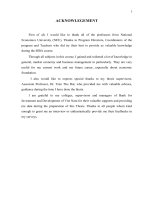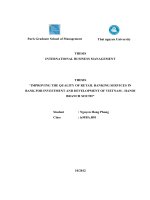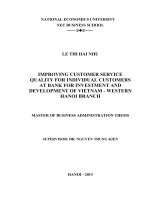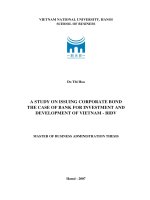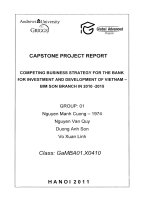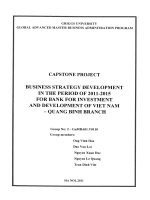Job satisfaction of employees of joint stock commercialbank for investment and development of viet nam (BIDV)
Bạn đang xem bản rút gọn của tài liệu. Xem và tải ngay bản đầy đủ của tài liệu tại đây (1.96 MB, 69 trang )
RESEARCH PROJECT
(BMBR5103)
JOB SATISFACTION OF EMPLOYEES
OF JOINT STOCK COMMERCIALBANK FOR INVESTMENT AND
DEVELOPMENT OF VIETNAM (BIDV)
STUDENT’S FULL NAME:
NGUYEN LUU DIEN TUONG
STUDENT ID:
CGS00018514
INTAKE:
SEPTEMBER 2014
ADVISOR’S NAME AND TITLE: DR. KHAI NGUYEN
December, 2015
ADVISOR’S ASSESSMENT
----------------------------------------------------------------------------------------------------------------------------------------------------------------------------------------------------------------------------------------------------------------------------------------------------------------------------------------------------------------------------------------------------------------------------------------------------------------------------------------------------------------------------------------------------------------------------------------------------------------------------------------------------------------------------------------------------------------------------------------------------------------------------------------------------------------------------------------------------------------------------------------------------------------------------------------------------------------------------------------------------------------------------------------------------------------------------------------------------------------------------------------------------------------------------------------------------------------------------------------------------------------------------------------------------------------------------------------------------------------------------------------------------------------------------------------------------------------------------------------------------------------------------------------------------------------------------------------------------------------------------------------------------------------Advisor’s signature
NGUYEN THE KHAI
2
ACKNOWLEDGEMENT
This study would not have been possible without the support and
encouragement received from so many people.
Firstly, I would like to thank to Dr. Khai Nguyen for giving me the opportunity
to receive the advanced education which I have also experienced one of the best stages
in my life.
I would like to express my deepest gratitude to my classmates for enabling me
to work on this study. I would like to thank other teachers for providing me with the
great guidance throughout the whole course of the work. I am also thankful for his
being patient when I presented my problems and ideas, as often I had difficulty
finding way to address them in a concise and succinct manner. Moreover, I am also
thankful my opponent who contributes me his supportive ideas and suggestion for my
research.
Greatest thanks to my dear parents, for supporting me and guiding me.
Finally, I would like to thank everyone who has assisted me in this project in
one way or another.
3
TABLE OF CONTENTS
ADVISOR’S ASSESSMENT ........................................................................................ 2
ACKNOWLEDGEMENT .............................................................................................. 3
LIST OF FIGURES ........................................................................................................ 6
LIST OF TABLES.......................................................................................................... 7
ABBREVIATIONS ........................................................................................................ 8
ABSTRACT ................................................................................................................... 9
CHAPTER 1: INTRODUCTION ................................................................................. 10
1.1.
Company introduction ....................................................................................... 10
1.2.
Research introduction ......................................................................................... 14
1.2.1.
Statement problem .......................................................................................... 14
1.2.2.
Research objectives ......................................................................................... 14
1.2.3.
Research questions .......................................................................................... 15
1.2.4.
Scope of the research ...................................................................................... 15
1.2.5.
Research design............................................................................................... 15
CHAPTER 2: LITERATURE REVIEW...................................................................... 17
2.1.
Job Satisfaction ................................................................................................... 17
2.2.
Satisfaction with work schedule flexibility ........................................................ 19
2.3.
Supportive supervision ....................................................................................... 20
2.4.
Perceived organizational support ....................................................................... 21
2.5.
Distributive justice ............................................................................................. 23
CHAPTER 3: RESEACH MODEL AND HYPOTHESES ......................................... 25
3.1.
Research Model .................................................................................................. 25
3.1.1.
Dependent Variables: ...................................................................................... 25
3.1.2.
Independent Variables: ................................................................................... 25
3.1.3.
Constructs........................................................................................................ 25
3.2.
Research Hypotheses .......................................................................................... 26
3.3.
Instruments ......................................................................................................... 32
3.4.
Sampling Method and sample size: .................................................................... 35
3.5.
Data analysis method: ........................................................................................ 36
4
3.6.
Method of data collection ................................................................................... 39
CHAPTER 4: ANALYSIS AND RESULTS ............................................................... 40
4.1.
Demographic Characteristics of the Respondents .............................................. 40
4.2.
Reliability Analysis ............................................................................................ 41
4.3.
Descriptive statistics ........................................................................................... 43
4.4.
Correlations among variables ............................................................................. 43
4.5.
Hypothesis testing results ................................................................................... 45
CHAPTER 5: CONCLUSION ..................................................................................... 47
5.1.
Summary and Discussion: .................................................................................. 47
5.2.
Limitation and recommendation for future research .......................................... 48
5.2.1.
The limitations of the study: ........................................................................... 48
5.2.2.
The next research ............................................................................................ 49
REFERENCES ............................................................................................................. 50
APPENDIX 1 ............................................................................................................... 55
APPENDIX 2 ............................................................................................................... 64
5
LIST OF FIGURES
Figure 1: Proposed the Research Model of Job Satisfaction of Employees in
BIDV
Figure2: A summary of demographic characteristics of the respondents
6
LIST OF TABLES
Table 1: Summary of hypotheses
Table 2: Cronbach's Alpha- Internal consistency
Table 3: Summary of Cronbach’s Alpha of the variables
Table 4: Descriptive Statistics
Table 5: Correlations among Variables
Table 6: Model Summary of all hypotheses
Table 7: Coefficients of all hypotheses
Table 8: Hypothesis Statistic
7
ABBREVIATIONS
BIDV
Joint stock commercial bank for investment and development of
Vietnam
HRM
Human Resource Management
SPSS
Statistical Packages for the Social Science
JS
Job Satisfaction
SW
Satisfaction with work schedule flexibility
SS
Supportive supervision
OS
Perceived organizational support
DJ
Distributive justice
8
ABSTRACT
A study was undertaken to measure the level of job satisfaction in BIDV. The
study mainly reviews around the view of employees regarding the job satisfaction.
What they think about the job satisfaction. The data was collected all primary, as
collected through personal interviews in the form of questionnaire.
This research aimed to identify the factors that impact the satisfaction among
staff working at BIDV. The research results indicated four groups of factors
(variables) which had impacted on these staff’s satisfaction namely: Satisfaction with
work schedule flexibility, Supportive supervision, Perceived organizational support,
Distributive justice.
Data analysis revealed that there is a positive relationship between the each
factor of employee satisfaction which is named satisfaction from Supportive
supervision, Perceived organizational support, Distributive justice. Furthermore,
relevant recommendations for improving the employee satisfaction are proposed.
9
CHAPTER 1: INTRODUCTION
1.1.
Company introduction
As a long-established bank, BIDV has funded many investment projects and
key economic areas of the country. Joint Stock Commercial Bank for Investment and
Development of Vietnam (BIDV) has also built the largest enterprise customers, while
confirming the implementation of prestigious items, objectives, economic programs
and social security of the country.
Full name: Joint Stock Commercial Bank for Investment and Development of
Vietnam.
Abbreviated name: BIDV
Founded on 04/26/1957, BIDV is the oldest Commercial Banking Vietnam.
HISTORY OF BIDV
History of construction and development of BIDV is a difficult and trial but
very proud path associating with historic period against invaders and country
construction of Vietnam people.
- Founded on 26th April 1957 under the name Bank for Construction of
Vietnam.
- From 1981 to 1989: Under the name Bank for Investment and Construction of
Vietnam.
- From 1990 to 27/04/2012: Under the name Bank for Investment and
Development of Vietnam (BIDV).
- From 27/04/2012 to now: Under the name Joint Stock Commercial Bank for
Investment and Development of Vietnam (BIDV).
10
History of construction and development of BIDV is a difficult and trial but
very proud path associating with historic period against invaders and country
construction of Vietnam people.
Along with country development, Joint Stock Commercial Bank for Investment
and Development of Vietnam contributed to postwar economic rehabilitation and
implementation of the first five-year plan (1957-1965). Vietnam must carry out two
strategic duties for building socialism. They are to be against sabotage of America
toward the North and to reinforce the South for national unity (1965-1975),
construction and development of national economy (1975-1989) and implementation
of the reform in banking activity serving country’s modernization (1990-now). In any
circumstances, BIDV personnel always accomplish their mission- to be a solider of
the Party on monetary financial front and investment and development of country…
Acknowledge the contribution of BIDV through the periods, the Party and the
Socialist Republic of Vietnam have given to BIDV a lot of noble titles and rewards
including First-Rate Independence Medal and Third-Rate Independence Medal; FirstRate, Third- Rate Labor Medal, recognize as hero of Labor in renovation period, Ho
Chi Minh Medal, etc.
FIELDS OF OPERATION
Bank: BIDV functions as a leading experienced bank of finance services,
brokerage, loan syndication and advisory, modern, convenient banking products.
Insurance: BIDV provides products for non-life insurance designed to match
the overall package to customers of BIDV.
Stock: BIDV provides a wide range of brokerage services, investment and
investment consultant with the ability of quickly developing a system of agents to
receive orders nationwide.
Financial investments: BIDV includes financial leasing, security trading and
capital contribution with the aim at establishing investment companies to the project;
Especially, it plays a leading role in coordinating key projects of the country such as
company Aviation stock leasing (VALC) development company highway (BEDC),
Investment, Long Thanh International Airport …
HUMAN RESOURCES
11
With more than 18,000 officers, employees and financial consultants who are
well-qualified and well-trained with full experience and have been accumulated and
transferred for over half of a century, BIDV always brings its customers the benefits
and reliability.
NETWORK
- Banking Network: BIDV has 127 branches and 600 transaction offices,
thousands of ATM and POS transactions in 63 provinces and cities nationwide
- Non-banking Networks: consists of Investment Securities Company (BSC),
Insurance and Investment Company (BIC) and Leasing Company with more than 20
branches nationwide.
- Overseas representatives: It trades on all three sectors: Banking, Insurance
and Financial Investment in Laos, Russia and especially in the Cambodian market
(Investment and Development Company of Cambodia – IDCC, Investment Banking
and Development of Cambodia – Cambodian BIDC, Insurance Company – CVI.
- Joint venture Bank: Co-operates more effectively with international partners
such as Bank VID-Public Venture (partner Malaysia), Bank of the Lao-Vietnamese
joint venture (with partner Laos), Vietnam Russia Joint Venture Bank – VRB (with
partners Russian), BIDV Tower Joint Venture Company (Singapore partner), and
venture investment management BIDV – Vietnam Partners (U.S. partner), etc.
CUSTOMERS
BIDV trades with:
- Enterprises: corporations, big corporations, small and medium enterprises
- Financial institutions: BIDV is the reliable choice for a number of Financial
institutions such as unilateral and multilateral World Bank, ADB, JBIC, NIB …
- Individuals: Millions of individuals have used the services of BIDV. It has
continuously tried to reach the goal of becoming a retail bank of high standards.
TECHNOLOGY
- BIDV always has innovations and technology applications serving effectively
for the management and development of advanced banking services, developing the
most advanced information technology systems such as ATM, POS, Contact Center,
to consolidate and develop all infrastructure systems such as monitoring of network
12
resources, network-oriented services (SONA), access control workstation; enhance
information processing service, banking executive management MIS; CRM.
- Since 2007, BIDV has occupied the leading position in the top list of
Vietnam ICT Index (index available for application development and information
technology) and in the typical Top 10 CIO (Information Technology Leadership) in
the area of Indochina in 2009 and of ASIA in 2010.
COMMITMENT
- To customers: BIDV always provides all customers with high quality
products and modern banking service and it is the last to be responsible for the given
services.
- To other partners: BIDV is willing to “share the opportunity and co-operate
successfully”.
- To working staff: BIDV follows the motto “each staff must be a competitive
edge” in both professional skills and personal virtue. For this reason, BIDV has
continually paid attention to ensuring legitimate rights, improving physical and
spiritual life of its employees to make them feel comfortable and inspired to serve in
BIDV.
BUSINESS REPUTATION OF BIDV
- BIDV is the choice, the trust for economic organizations, the leading
enterprises of both countries and individuals in accessing the financial and banking
services.
- BIDV has been known and recognized as one of the largest banking brand in
Vietnam and certified as a trademark in the U.S. and also rewarded annually from
organizations, financial institutions at home country and abroad.
- BIDV is always the pride of generations of staff and financial and banking
sector in 55 years with traditional professional development investment for the
country
13
1.2.
Research introduction
1.2.1. Statement problem
Today, in addition to the two inputs are important financial resources and
materials quality, human resources is becoming increasingly important for
organizations in general and for the commercial banks in particular. In fact, the
organization, the successful bank is good governance, their human resources (Sylvie
St-Onga ET all, 2004). In other words, it is the bank has lifted the challenges of
human resources, ensuring management and staff training plan that meets the needs of
personnel for each stage of their development. Some of these challenges are related to
the satisfaction of employees on their work. Throughout life, people spend a lot of
time to work, but that does not mean they love their work. The level of employee
satisfaction is one of the criteria for evaluating the success of the business. Once
employees feel satisfied with the work, they will work efficiently and get on with the
company. Human resources is an invaluable asset of the enterprise, it determine
whether or competitive position of the business in the marketplace. Especially for
service industries, service providers and the interactions between staff and clients are
important factors directly affecting the quality of products and services and customer
satisfaction groin.
On the other hand, improve the satisfaction level of employees will maintain
the stability of the workforce, reduce operating costs and increase business
productivity. Raise the level of employee satisfaction not merely rise. There are many
simple methods, inexpensive help managers improve satisfaction and increase levels
of employee commitment.
So in this article, we focused on identifying and analyzing the impact of these
factors on job satisfaction of employees of BIDV based on survey data of 290
employees in the bank.
1.2.2. Research objectives
This study will need to find out which factors affect the employees' satisfaction
and how to improve it. To achieve this overall goal, we need to achieve these specific
objectives:
14
- Satisfaction with work schedule flexibility.
- Supportive supervision
- Perceived organizational support
- Distributive justice index
1.2.3. Research questions
Based on the discussion above, and to accomplish the objective of this study,
these research questions have been formulated:
1. The relationship between Satisfaction with work schedule and Job
satisfaction
2. The relationship between Supportive supervision and Job satisfaction
3. The relationship between Perceived organizational support and Job
satisfaction
4. The relationship between Distributive justice and Job satisfaction
1.2.4. Scope of the research
Due to limited time and resources, the study focuses on employees who can be
contacted to answer the questionnaire. These questions mainly focus on the
satisfaction of employees BIDV with 290 employees.
1.2.5. Research design
Data collection: Data Collection is an important aspect of any type of research
study. Inaccurate data collection can impact the results of a study and ultimately lead
to invalid results. Data collection methods for impact evaluation vary along a
continuum. At the one end of this continuum are quantitative methods and at the other
end of the continuum are Qualitative methods for data collection. Both primary and
secondary data had been used in present study.
Primary data
- Survey received from the employees of BIDV.
- Results of interviews, discussions with employees to better understand the
views and plan, as well as reviews of study issues.
15
Secondary data
The theoretical basis and the selected article on the journal of marketing,
journal of education is an important source of secondary data for research.
16
CHAPTER 2: LITERATURE REVIEW
2.1.
Job Satisfaction
Many theorists have tried to come up with an explanation for why people feel
the way they do in regards to their job. Locke developed the idea known
as discrepancy theory. This theory suggests that a person's job satisfaction comes from
what they feel is important rather than the fulfillment of their needs. A person's
importance rating of a variable is referred to "how much" of something is wanted.
Discrepancy theory suggests that dissatisfaction will occur when a person receives
less than what they want (Berry, 1997).
Another theory was developed by Lawler. Lawler believed that job satisfaction
was driven by a motivational framework. This idea deals with how a person measures
job satisfaction based on what they got verses what they feel they deserved.
Satisfaction is determined by the difference between the exact amount a person
received and what they expected. Therefore, dissatisfaction occurs when a person
receives less or more than what was expected.
In order to put job satisfaction in an environmental perspective, Social
Psychologist Bandura developed a theory known as the social influence hypothesis.
This hypothesis describes a social effect where individuals want what they perceive
others around them to want. The last theory used to explain job satisfaction was
proposed by Landy. His theory is known as the opponent process theory. He
suggested that the primary reaction (the immediate emotional response) combined
with the secondary reaction (the later emotional response) creates a stabilized
equilibrium which results in job satisfaction.
Despite its vide usage in scientific research, as well as in everyday life, there is
still no general agreement regarding what job satisfaction is. In fact there is no final
definition on what job represents. Therefore before a definition on job satisfaction can
be given, the nature and importance of work as a universal human activity must be
considered. Different authors have different approaches towards defining job
satisfaction. Some of the most commonly cited definitions on job satisfaction are
analyzed in the text that follows. Hoppock defined job satisfaction as any combination
17
of psychological, physiological and environmental circumstances that cause a person
truthfully to say I am satisfied with my job (Hoppock, 1935). According to this
approach although job satisfaction is under the influence of many external factors, it
remains something internal that has to do with the way how the employee feels. That
is job satisfaction presents a set of factors that cause a feeling of satisfaction. Vroom
in his definition on job satisfaction focuses on the role of the employee in the
workplace. Thus he defines job satisfaction as affective orientations on the part of
individuals toward work roles with them are presently occupying (Vroom, 1964). One
of the most often cited definitions on job satisfaction is the one given by Spector
according to whom job satisfaction has to do with the way how people feel about their
job and its various aspects. It has to do with the extent to with people like or dislike
their job. That why job satisfaction and job dissatisfactions can appear in any givers
work situation. Job satisfaction represents a combination of positive or negative
feelings that workers have towards their work. Meanwhile, when a worker employed
in a business organization, brings with it the needs, desires and experiences which
determinates expectations that he has dismissed. Job satisfaction represents the extent
to which expectations are and match the real awards. Job satisfaction is closely linked
to that individual's behavior in the work place (Davis et al., 1985). Job satisfaction is a
worker’s sense of achievement and success on the job. It is generally perceived to be
directly linked to productivity as well as to personal well-being. Job satisfaction
implies doing a job one enjoys, doing it well and being rewarded for one’s efforts. Job
satisfaction further implies enthusiasm and happiness with one’s work. Job
satisfaction is the key ingredient that leads to recognition, income, promotion, and the
achievement of other goals that lead to a feeling of fulfillment (Kaliski, 2007). Job
satisfaction can be defined also as the extent to which a worker is content with the
rewards he or she gets out of his or her job, particularly in terms of intrinsic
motivation (Statt, 2004). The term job satisfaction refers to the attitudes and feelings
people have about their work. Positive and favorable attitudes towards the job indicate
job satisfaction. Negative and unfavorable attitudes towards the job indicate job
dissatisfaction (Armstrong, 2006). Job satisfaction is the collection of feeling and
beliefs that people have about their current job. People’s levels of degrees of job
18
satisfaction can range from extreme satisfaction to extreme dissatisfaction. In addition
to having attitudes about their jobs as a whole, people also can have attitudes about
various aspects of their jobs such as the kind of work they do, their coworkers,
supervisors or subordinates and their pay (George et al., 2008). Job satisfaction is a
complex and multifaceted concept which can mean different things to different
people. Job satisfaction is usually linked with motivation, but the nature of this
relationship is not clear. Satisfaction is not the same as motivations. Job satisfaction is
more of an attitude, an internal state. It could, for example, be associated with a
personal feeling of achievement, either quantitative or qualitative (Mullins, 2005). We
consider that job satisfaction represents a feeling that appears as a result of the
perception that the job enables the material and psychological needs (Aziri, 2008). Job
satisfaction can be considered as one of the main factors when it comes to efficiency
and effectiveness of business organizations. In fact the new managerial paradigm
which insists that employees should be treated and considered primarily as human
beans that have their own wants, needs, personal desires is a very good indicator for
the importance of job satisfaction in contemporary companies. When analyzing job
satisfaction the logic that a satisfied employee is a happy employee and a happy
employee is a successful employee.
2.2.
Satisfaction with work schedule flexibility
This measure was developed by Rothausen (1994), uses a five-item scale to
measure employee satisfaction with work schedule flexibility. It measures the extent
to which an employee feels he or she has flexibility in scheduling work, in doing parttime or flexibility work, and in balancing work and family responsibilities.
By Susan M. Heathfield, Human resources Expert, A flexible schedule allows
an employee to work hours that differ from the normal company start and stop time.
Particularly in an environment for exempt employees, those hours are generally 8
a.m.-5 p.m. or 9 a.m.-6 p.m. and total a 40 hour work week.
A flexible schedule is also dependent on employee availability to cover all
aspects of the job and all hours of the day during which a business makes product or
serves customers. A flexible schedule is one of the benefits that is most appreciated by
19
employees - even more so by your millennial employees. The advantages when a
flexible schedule is allowed, to both employers and employees are the key as you
implement a flexible schedule.
Satisfaction
with
schedule
flexibility
correlated
positively
with
organizational commitment and supervisor work – family support. Satisfaction
with flexibility correlated negatively with turnover intentions (Aryee et al., 1998).
Baltes et al. (1999); Scandura & Lankau, (1997) described that flexible work
arrangements provided to employees allow them to work according to their ease,
which in result will minimize the amount of stress
2.3.
Supportive supervision
This measure was developed by Oldham and Cummings (1996), uses 08 items
to describe
employee
perceptions
of
the
extent
to
which
they
receive
supervisory support (eight items) and are subject to a non –controlling supervisory
approach (four items). When supervisors are supportive, they show concern for
employees’ feelings and needs; encourage them to voice their
own
concerns;
provide positive, chiefly informational feedback; and facilitate employee skill
development (Deci, Connell, & Ryan, 1989). When supervisors are controlling, they
closely monitor employee behavior; make decisions without employee involvement;
provide feedback in a controlling manner; and generally pressure employees to think,
feel, or behave in prescribed ways (Oldham & Cummings, 1996).
By Eisenberger et al. 2002, Supervisor support is defined as employees’ belief
concerning the extent to which supervisors value their contributions and care about
their well-being. Employees need motivation to expend greater efforts and more
personal resources in innovative tasks when supervisor exhibit their individual
consideration toward followers, followers are likely to perceive the warmth and
consideration from their supervisors. Similarly, employees who perceive support from
their supervisors often feel obligated to pay back supervisors’ favors or kindness by
helping supervisors to reach their stated goals.
This means that employees who perceive a fair balance between supervisor’s
inducements relative to their work efforts will respond with more innovative behavior.
20
According to social exchange theory additional arguments can be derived for a
relationship between supervisor support and innovative behavior. Direct supervisors
can act as organizational agents. Employees tend to view actions by agents of the
organization as actions of the organization itself.
2.4.
Perceived organizational support
This measure was developed by Eisenberger et al. (1986), describes employee
perceptions about the extent to which an organization is willing to reward greater
efforts by the employee because the organization values the employee’s contribution
and cares about his or her well-being. The measure includes eight items that measure
an employee’s perception of the degree to which the organization values the worker’s
contributions and nine items about actions that the organization might take that would
affect the well-being of the employee. Some studies have used an abbreviated version
consisting of the nine items with the highest factor loadings in the original scale
development study (Moorman, Blakely, & Niehoff, 1998; Wayne, Shore, & Liden,
1997).
Perceived organizational support correlated positively with overall job
satisfaction, organizational commitment, direct and indirect control at work, job
discretion, interpersonal
pay/promotion
helping,
affective
attachment
to
the
organization,
expectancies, approval/recognition expectancies, and employee
performance ratings (Cropanzano et al., 1997; Eisenberger et al., 1997; Eisenberger et
al., 1990; Hutchinson et al., 1998; Lee & Ashforth 1993; Moorman et al., 1998).
Perceived
organizational
organizational
emotional
politics,
support
correlated
turnover intentions,
days
negatively with
absent,
role
perceived
stress,
and
exhaustion (Cropazano et al., 1997; Eisenberger et al., 1990; Lee &
Ashforth, 1993). Wayne, Shore, and Liden (1997) found through factor analysis
that
perceived organizational
developmental
experiences,
support
was
empirically
distinct
from
leader –member exchange (LMX), affective
commitment, and intentions to quit. Eisenberger et al. (1997) found through
confirmatory factor analysis that perceived organizational support and overall job
satisfaction were empirically distinct.
21
Supportive leader behaviors and a generally facilitative organizational climate
may be subsumed under a variable entitled “Perceived Organizational Support.”
Eisenberger, Huntington, Hutchison, and Sowa (1986) demonstrated that individuals
tend to “form global beliefs concerning the extent to which the organization values
their contributions and cares about their well-being” (p. 504). Specifically, individuals
evaluate the behavior of organizational agents towards them and infer the general
motive underlying that treatment, with the categories that are considered important
varying considerably between organizations and be- tween persons. Some individuals
might base their sense of perceived organizational support upon such factors as the
organization members’ willingness to provide them with special assistance or special
equipment in order to complete a project. Others might develop a strong sense of
perceived organizational support based upon the organization members’ willingness to
provide them with additional opportunities for training in an area that was of
particular interest to them. Furthermore, employees are frequently sensitive to relevant
environmental and organizational constraints that might limit the ability to provide
them with desired rewards (Eisenberger, Cummings, Armeli, & Lynch, 1997).
Employees who experience a strong level of perceived organizational support
theoretically feel the need to reciprocate favorable organizational treatment with
attitudes and behaviors that in turn benefit the organization (Eisenberger et al., 1986).
In support of this social exchange perspective, research has revealed that perceived
organizational support is positively related to job attendance and measures of job
performance (Eisenberger et al., 1986; Eisenberger, Fasolo, & Davis-LaMastro,
1990), the tendency to help coworkers (Shore & Wayne, 1993), the tendency to offer
constructive suggestions for organizational improvement, and affective organizational
commitment (Eisenberger et al., 1990).
Overall, it appears that employees with higher levels of perceived
organizational support are likely to be more committed and possibly more willing to
engage in extra role or “organizational citizenship” behaviors (Organ, 1988) than are
employees who feel that the organization does not value them as highly.
22
2.5.
Distributive justice
This measure was developed by Price and Mueller (1986). It focuses on
assessment of the degree to which rewards by employee are perceived include effort,
experience, and education. Distributive justice is judged high in an organization
when effort, experience, good work, and dealing with stresses and strains of a job are
rewarded and their absence punished. The original items were modified by Mansour –
Cole and Scott (1998) to assess the degree of perceived fairness in an employee’s
work situation compared with co –workers.
By Nozick's theory, distributive justice is how a society or group should
allocate its scarce resources or product among individuals, the justice that is
concerned with the apportionment of privileges, duties, and goods in consonance with
the merits of the individual and in the best interest of society.
Distributive justice concerns the fair, just or equitable distribution of benefits
and burdens. These benefits and burdens span all dimensions of social life and assume
all forms, including income, economic wealth, political power, taxation, work
obligations, education, shelter, health care, military service, community involvement
and religious activities. Thus, justice arguments are often invoked in connection with
minimum wage legislation, Affirmative Action policies, public education, military
conscription, litigation, as well as with redistributive policies such as welfare,
Medicare, aid to the developing world, progressive income taxes and inheritance
taxes. Distributive justice enjoys a long and honored tradition in political, economic
and social thought. It is central to Aristotle’s Nichomachean Ethics (1976) and Politics
(1999). In modern political philosophy, it has been construed in broad terms and seen
as a foundational for policy formation and analysis. Michael Walzer (1976), for
example, writes that “Distributive justice is a large idea,” and for John Rawls (1976)
“Justice is the first virtue of social institutions.” Thus, it is widely regarded as an
important concept and influential force in philosophy and the social sciences. This
description begs the question, however, of what, exactly, constitutes a “fair,” “just” or
“equitable” distribution (we will use these terms interchangeably). It seems that justice
terminology is employed with considerable flexibility, and fairness arguments are
23
sometimes even made by both parties on opposite ends of a dispute. There are at least
three reasons for this.
By Michelle Maiese (June 2013) Distributive justice is concerned with the fair
allocation of resources among diverse members of a community. Fair allocation
typically takes into account the total amount of goods to be distributed, the
distributing procedure, and the pattern of distribution that result.
Distributive justice correlated positively with job satisfaction, procedural
justice, interactive justice, and the organizational citizenship behaviors of
courtesy, altruism, sportsmanship, and conscientiousness ( Moorman, 1991 ).
Distributive justice also correlated positively with employee sense of control,
extent to which an employee benefited personally from a structuring and layoff,
leader – member exchange with his or her manager, pay satisfaction, employee age,
job satisfaction, subordinate’s evaluation of his or her supervisor, and organizational
commitment ( Mansour – Cole & Scott, 1998; McFarllin & Sweeney, 1992;
Sweeney & McFarlin,1993). Sweeney and McFarlin (1993) found through
confirmatory factor analysis that distributive justice was one dimensional with the
items loading as expected. These analyses also found that distributive and procedural
justice were empirically distinct. DeConinck, Stilwell, and Brock (1996) found
through confirmatory factor analysis that distributive justice was empirically
distinct from four dimensions of the Pay Satisfaction Questionnaire ( satisfaction with
benefits, last raise, pay level and structure, and administration of the pay plan ).
24
CHAPTER 3: RESEACH MODEL AND HYPOTHESES
3.1.
Research Model
Satisfaction with work schedule
flexibility
+
H1
+
H2
+
H3
+
H4
Supportive supervision
Perceived organizational support
Job Satisfaction
Distributive justice
Figure 2: Proposed the Research Model of Job Satisfaction of Employees in BIDV
3.1.1. Dependent Variables:
- Job Satisfaction
3.1.2. Independent Variables:
- Satisfaction with work schedule flexibility
- Supportive supervision
- Perceived organizational support
- Distributive justice
3.1.3. Constructs
+
- Key construct: Job Satisfaction (JS)
- Other constructs:
25
